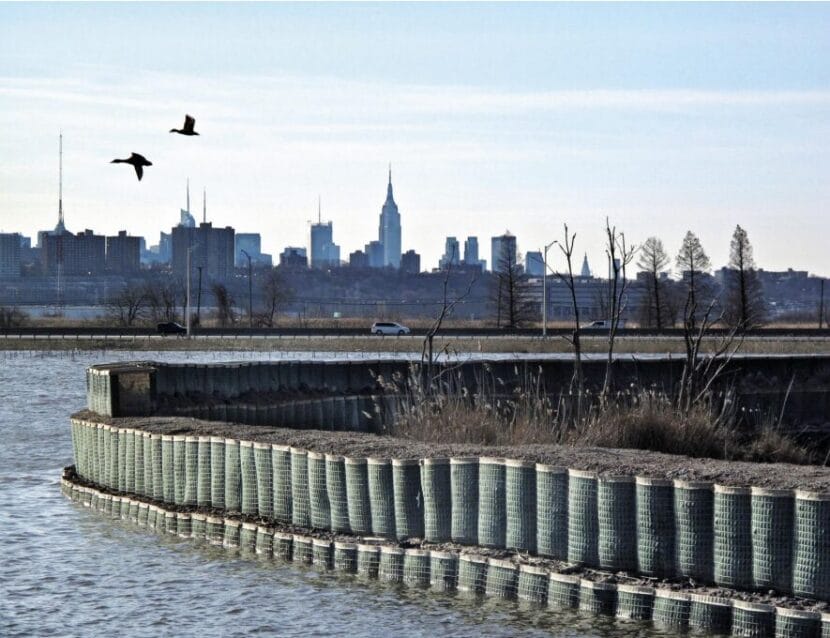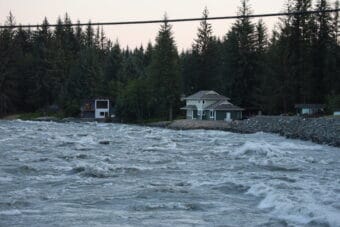
The City and Borough of Juneau is moving forward with phase one of their short-term plan to fight glacial outburst floods in the Mendenhall Valley. A proposal to construct a temporary levee along the Mendenhall River using flood barriers is already underway.
At Monday evening’s Assembly committee of the whole meeting, flood fighting experts shared details about barrier installation and durability. The city has debated the best way to address Juneau’s outburst floods, but the U.S. Army Corp of Engineers recommended building the levee using barriers made by a company called HESCO.
“It’s quick, it’s really effective and it’s inexpensive. That’s why we’re suggesting the HESCO barriers,” said Dan Allard, an emergency management specialist for the Corps’ Alaska branch.
The HESCO barriers were given to the city for free by the Corps. They are four feet tall and three square feet wide, made with heavy-duty fabric sandbags contained in a metal wire basket. For Juneau’s plan, they’d be used to line the riverbanks on the developed side of the Mendenhall River along Marion Drive, Killewich Drive and Meander Way.
Some Juneau residents have expressed concern about the possibility that the flood barriers could be breached by debris, like the large trees that often come down during outburst floods.
Keith Anderson, a consultant with Flood Defense Group and a former HESCO employee, also addressed the Assembly. Anderson, who has built HESCO levees for military fortification and flood fighting across the nation, said that the barriers are able to withstand trees and all kinds of impacts.

“The bulk of these baskets, they can take floodwater, debris impact, car bombs, rockets, I mean, it’s amazing how strong they are,” he said.
At least one catastrophic breach of HESCO barriers has been documented when the flooded Mississippi River broke through in Davenport, Iowa and surged into the city’s downtown. That incident, Anderson said, was attributed to a construction error.
The bigger concern, experts said on Monday, is not barriers failing, but bank failure due to erosion. During the rollout of the plan, the city has made it clear that significant site preparation on private property may be necessary.
“You may think we’re eering in caution on recommending bank stabilization or armouring protection or scouring protection in front of these barriers, but we’re trying to provide a product at our best assurances that will last more than one event,” said John Bohan, chief engineer with the city’s capital improvement project.
The Corps will fund the cost for engineering and design of the levee, as well as its temporary construction, but they can’t chip in for erosion protection in this case. So making the bank strong enough for the levee will likely demand some significant cost-share for property owners, and some invasive work.
“You also have to provide rights of entry to people’s property so you can put these things up, and that might be an issue because it’s not area beautification, right? It’s flood protection,” Allard said.
During August’s record-breaking glacial outburst, 289 homes in Mendenhall Valley were damaged by flood water. But some property owners in riverfront neighborhoods have already expressed opposition to the city’s plan.
While some residents say they’re worried about the financial aspects, others worry about the possibility that flood barriers could redirect flood water in unexpected ways, potentially sending more powerful flows to downstream neighborhoods, for instance.
Bohan acknowledged that the city is working with incomplete information while designing the levee project, but an updated hydrologic study of the Mendenhall River, with accompanying inundation maps for the Mendenhall Valley, will be done by the engineering firm Michael Baker International. Preliminary results of that study are expected later this month, before flood barriers are installed.
Some residents have also been pushing for more substantial flood fighting solutions, like dredging the Mendenhall River or building a levee around the lake. The city has already set aside $3 million to study those more permanent solutions, but experts from the Corps at Monday’s meeting said the agency would be unable to pursue those ideas without further investigation, including economic and environmental studies that could take years.
“Even if we do it quickly, it’s still going to be a long time. Much more time than you have to protect the people down on the river,” Allard said.
The HESCO levee, Allard said, is a way to buy time. The city plans to present more detailed plans on site preparation and potential cost sharing for the HESCO levee plan at the next regular Assembly meeting on Nov. 16.
